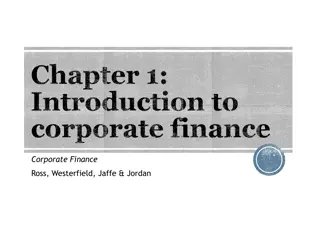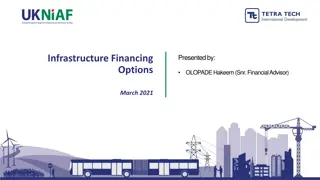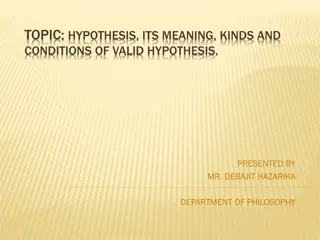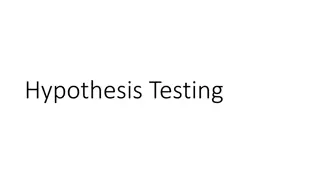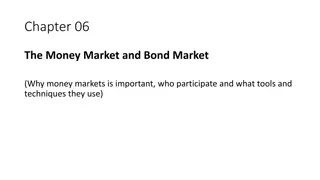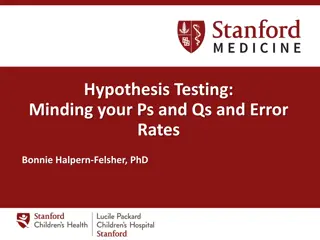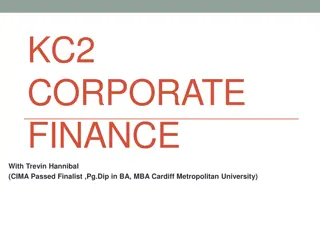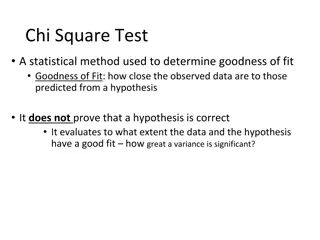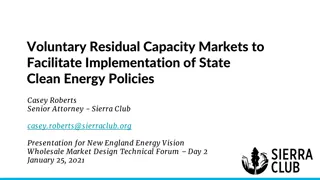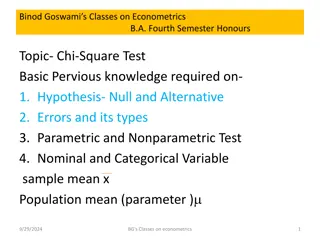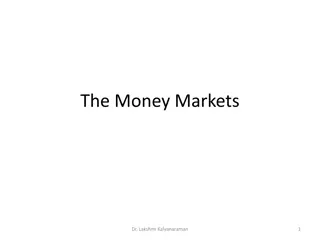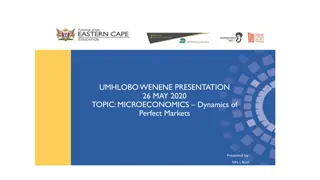Understanding Efficient Markets Hypothesis in Corporate Finance
Explore the concepts of efficient markets hypothesis (EMH) and adaptive markets hypothesis (AMH) in corporate finance. EMH posits that all information is instantly reflected in stock prices, while AMH suggests a gradual process based on the number of analysts. Learn about different forms of market efficiency and how securities regulations influence stock price movements. Gain insights into how information processing impacts stock prices and sustainability considerations.
- Corporate Finance
- Efficient Markets Hypothesis
- Adaptive Markets Hypothesis
- Market Efficiency
- Stock Prices
Download Presentation

Please find below an Image/Link to download the presentation.
The content on the website is provided AS IS for your information and personal use only. It may not be sold, licensed, or shared on other websites without obtaining consent from the author. Download presentation by click this link. If you encounter any issues during the download, it is possible that the publisher has removed the file from their server.
E N D
Presentation Transcript
CORPORATE FINANCE FOR LONG-TERM VALUE Chapter 14: Capital market adaptability, investor behaviour and impact
Part 4: Risk, return and impact Chapter 14: Capital market adaptability, investor behaviour and impact
The BIG Picture 3 How is information processed into stock prices? Discussion Finance adopts traditionally the efficient markets hypothesis (EMH): all information is immediately (with the speed of light) incorporated in prices An alternative is the adaptive markets hypothesis (AMH): information is gradually (with the speed of thinking) incorporated in prices depending on the # of analysts AMH seems more appropriate for getting sustainability into prices Implicit markets (e.g. elections, consumers, NGOs) reveal impact information
Efficient markets hypothesis 4 Stock prices are one of the most closely followed news items, but can a pattern or price cycle be discerned? According to the efficient markets hypothesis, there are no patterns in stock prices Stock prices change at random: tomorrow s stock price has an equal chance of going up or down Assuming an expected monthly return of 0.5%, stock prices follow a random walk with a positive drift of 0.5% per month (the drift reflects the mean return) The idea is that competition between investors eliminates profit opportunities
Efficient markets hypothesis 5 The efficient markets hypothesis (EMH) states that stock prices incorporate all relevant information instantaneously with the speed of light Fama (1970) distinguishes three forms of market efficiency: Weak market efficiency: prices reflect all relevant past information Semi-strong market efficiency: prices reflect not only information in past prices, but also all publicly available information Strong market efficiency: prices also reflect information gathered through fundamental analysis of the company and the economy Securities regulations force companies to publish information that can potentially move the stock price (i) outside trading hours and (ii) as widely as possible Spreading rumours about companies in order to manipulate stock prices is forbidden
EMH: Interest rate announcements 6 When central banks fear that the economy is getting overheated leading to inflation, they will try to slow this down by raising interest rates An interest rate rise has a negative impact on future profits and increases the discount factor Central banks follow a strict protocol on announcing their interest rate policy The European Central Bank (ECB) has a six-week schedule for their monetary policy meetings In the run-up to the meeting, the market speculates on the ECB s decision An unexpected interest rate rise (or decline) leads to an immediate reaction in stock prices Fierce competition among stock traders ensures that there is little opportunity to gain from the interest rate announcement
EMH: Takeovers and market efficiency 7 On December 1st, 2020, the Cloud computing giant, Salesforce, announced the acquisition of Slack Technologies for $27.7 billion dollars On the announcement date, the stock price of Slack jumped 38% There seems to have been some information CUMULATIVE ABNORMAL RETURN AROUND ACQUISITION OF SLACK TECHNOLOGIES BY SALESFORCE leakage prior to the announcement, given that CUMULATIVE ABNORMAL RETURNS % 80% the stock price increased by 22% 60% 40% The Cumulative Abnormal Return (CAR) shows 20% the deviation of Slack s realised return from its 0% expected market return, amounting to 60% -10 -9 -8 -7 -6 -5 -4 -3 -2 -1 EVENT TIME (T=0 ANNOUNCEMENT DATE) 0 1 2 3 4 5 6 7 8 9 10 Risk-Adjusted Return model
Strong market efficiency 8 The strong form of market efficiency argues that fundamental analysts cannot outperform the market This means there is no added value from fundamental analysis, while this analysis is costly to do Insider dealing is a criminal offence, although extremely difficult to prove in a criminal court Company management is not allowed to give stock-price sensitive information to individual investors or small groups of investors Companies therefore organise analyst calls, which are widely accessible to investors, to update investors on strategy, earnings outlook, etc.
The paradox in efficient markets hypothesis 9 The efficient markets hypothesis has a contradictory element in it All investors will be passive, as active trading strategies and information acquisition do not pay off in informationally efficient markets At the same time, we need active investors to acquire and process information to update market prices French (2008) finds that active investors spend around 70 basis points (0.7%) of the aggregate value of the market each year searching for superior returns As active investors can on average not increase their return with active trading strategies, they could improve their returns by 70 basis points if they switched to a passive market portfolio In conclusion, markets can only be close to efficiency, because some profit opportunities are needed for active investors
Financial investors and capital market competition 10 To analyse investor behaviour, we need to know the investor s goal function: The exclusively financially driven investor aims to maximise return and minimise risk measured using CAPM The required return of individual stocks ??from the CAPM is: basis for the security market line (SML) ??= ??+ ?? (?[????] ??) Investors may expect a higher return (Nestle) or lower return (Apple) than the required return on the SML The difference between a stock s expected return ?[??] and required return ??is a stock s alpha ?? 12% Security market line Expected return 10% Expected return: ?[??] = ??+ ??+ ?? (?[????] ??) Nestle 8% 6% Alpha Alpha Risk-free rate In competitive markets, all stocks are on the 4% Apple security market line with an alpha of zero 2% 0% 0 0.5 1 1.5 2 Beta
Behavioural finance 11 Are all investors acting in line with the expectations of the CAPM model? There are two major deviations: Familiarity bias of individual investors, who tend to invest in a few stocks of companies they are familiar with Often results in portfolios with less than 10 stocks, meaning investors fail to diversify appropriately Excessive trading, which means investors frequently trade their stocks, giving rise to high transaction costs, which reduces net investment returns The annual stock turnover on the largest stock exchanges is well over 100%, which means that all shares change hands at least once every year
Bubbles 12 The pricing of stocks in CAPM is based on homogeneous expectations What happens when investors collectively believe that the outlook is more favourable? Shiller (2000) has coined the term irrational exuberance which refers to investor enthusiasm that drives asset prices higher than those assets' fundamentals justify The cyclically adjusted price-to-earnings ratio (CAPE) measures over- or undervaluation of the market An average CAPE ratio of 15 for the 20thcentury, with 25 indicating significant overvaluation Example: the dotcom bubble Investors had high expectations about the internet and valued internet companies at very high prices The NASDAQ increased from 750 in early 1995 to 4700 in February 2000, when the dotcom bubble burst The dotcom bubble, NASDAQ Composite Index, 1995-2002 Source: Nasdaq
The cost of social and environmental capital 13 Andrew Lo s (2004; 2017) adaptive markets hypothesis states that the degree of market efficiency depends on an evolutionary model of individuals adapting to a changing environment (with the speed of thinking ) Unlike the efficient markets hypothesis, the adaptive markets hypothesis allows for: Path dependencies; Systematic changes in behaviour; and Varying risk preferences The adaptive markets hypothesis can explain why new factors, such as social and environmental risks and opportunities, are not yet fully priced in, because not enough investors are: Examining these new factors Expecting sustainable material risks and opportunities to lead to financial effects The question is how to get sustainability related information embedded into stock prices
Transition preparedness 14 As the UN Sustainable Development Goals are about transition, an investor needs to know how well or ill prepared an investee company is: Can the company s business model be adapted to a sustainable economy? Investors have to look at companies through a different lens, and go beyond traditional financial statement analysis Considering social and environmental factors in their own units Investigating governance and behaviour Assessing their impact on companies strategies and business models
Availability and quality of ESG data 15 Over time, sustainability reporting is expected to increase with new reporting initiatives Increasing availability of ESG data EU Corporate Sustainability Reporting Directive (CSRD) Hardly available quant data Pockets of data that can be harvested with a solid process - Being ahead of ratings can generate alpha International Sustainability Standards Board (ISSB) With this increased information, markets will adapt and thus become more efficient Shifting data frontier In sustainability reports soon The lack of available data is currently very large, but should diminish over time in line with the adaptive markets hypothesis In sustainability reports now Pockets of poorly used data as inefficiencies and opportunities to be exploited Embedded in ESG ratings Widely available quant data Widely available qualitative information Hardly available qualitative information Increased attention towards socially and environmentally relevant information will reduce alpha return on active investment exploiting market inefficiencies - to zero
Limitations of ESG ratings 16 ESG rating agencies score thousands of companies on several sustainability metrics within the E, S, and G (governance) domains Agencies include: MSCI, Sustainalytics, Refinitiv, ISS, etc. ESG ratings help indicate a company s level of environmental, social, and governance risk Only indicate a company s inward impact, not the outward ESG impact of the company Advantage: provides investors with a quick approximation of a firm s ESG risk Disadvantages: Difficult to compare, since each rating agency uses a methodology which differs in terms of scope and measurement (Berg, K lbel, and Rigobon, 2022) Ratings cannot be compared unless the company is operating in the same industry and has the same material ESG issues (as determined by the rating agency)
The impact perspective 17 The outward (or impact) perspective looks at the impact of companies on society and nature The impact dimension embodies the social and environmental value of companies, separate from financial value Impact information: Academic research NGOs Regulations Rating agencies Consultancies Impact prices: Direct: Consultancies Indirect: - Product markets - Capital markets - Elections Dependencies: inward Business & financial value Society & nature Internalisation rate Impacts: outward Financial information and prices: Capital markets
Impact information producers 18 Academic research has produced the planetary boundaries, which show how we can keep the Earth system in a stable and resilient state The Earth Commission underpin the development of science-based targets for systems like air, land, water, and biodiversity Over 3,000 businesses and financial institutions are working with the Science Based Targets initiative (SBTi) to reduce their emissions in line with climate science Non-governmental organisations (NGOs) are organisations that produce impact information, which is mostly about negative impacts Amnesty International publishes overviews of human rights abuses by companies and governments World Wildlife Fund (WWF) is the source for information on company impact on biodiversity loss Carbon Disclosure Project (CDP) reports on company s carbon emissions
Global Witness on deforestation 19 Agriculture is the main cause of deforestation: cattle (beef), palm oil and soy are the most important agricultural commodities contributing to land-use linked to deforestation An NGO - Global Witness (2021) has identified the top three companies active in these agricultural commodities: Cargill, the largest agricultural commodity trader of soy and beef, based in the United States JBS, the leading exporter of beef from South America, based in Brazil Wilmar, the largest refiner and trader of palm oil, based in Singapore While the annual reports of these companies contain statements that their commodities are deforestation free, the reality is that these companies are major contributors to deforestation Important to critically assess the information provided by companies Global Witness (2021) also highlights the role of banks financing these companies
Other impact information producers 20 Although the impact information produced by NGOs is highly valuable, they do not provide systematic coverage of the universe of listed companies Reporting regulations are starting to require companies to report on impact information The traditional credit rating agencies have started to include sustainability into their credit risk analysis ESG rating agencies are slowly shifting from measuring ESG risks (inward) to SDG impacts (outward) Ratings agencies complement NGOs by processing their data in a more investor friendly format for a wider investment universe Not yet in a systematic way that allows investors to assess the effect on EV and SV
Impact analysis 21 The Big Four accounting firms (Deloitte, KPMG, PwC and EY) have set up impact measurement divisions, which provide an integrated analysis of a company s value covering financial, social and environmental value Specialist impact consultants, like Impact Institute, measure impact and apply shadow prices for impact to monetise social and environmental value A good impact analysis meets the following criteria: Holistic: it covers all material impacts, positive and negative; no cherry-picking Material: it focuses on material impacts avoiding distraction by immaterial issues Comprehensible: it is written in a concise and accessible way Assurance: it is reviewed by a certified audit firm crucial to avoid the good news show
Impact markets and pricing 22 Impact prices should reflect true scarcity of resources or true price of human right breaches Also called shadow prices, as they don t reflect current market prices but shadow true prices Consultants, like the Impact Institute, produce regularly updated lists of impact prices for a whole range of social and environmental factors Impact prices translate science-based targets into actionable inputs for a company s decision-making and reporting High impact prices, reflecting true scarcity, provide an incentive for companies to explore cheaper alternatives For example, renewable energy is cheaper than fossil fuels, when shadow carbon prices are applied
Three impact markets 23 Product markets (consumers) Reveal consumer preferences for sustainable products and services A shift in demand can set into motion the transition from unsustainable to sustainable products in an industry Consumers willingness to pay for impact has so far been limited to a small part of the population Capital markets (investors) Examine investor preferences for impact investing, aiming for social and environmental value creation alongside financial value creation Impact investing data and engagement efforts provide an indication of preferences for certain types of impact- positive companies and where impact can be improved Elections (voters) Voters reveal their preferences for policies, including sustainability policies
Impact performance 24 We simply do not know whether individual companies are doing enough, or not; nor do we know by how much they are falling short One could pursue context-based sustainability, which connects the micro (companies in a certain sector), meso (country), and macro (system) levels to determine individual company contributions A system approach of thresholds and allocations has three steps: System level: determine the thresholds that should not be crossed; these thresholds are the planetary and social boundaries 1. Country level: allocate these thresholds to countries on an equal per capita basis 2. Sector level: allocate resources to sectors and individual companies on a forward-looking basis 3.
Impact performance 25 McElroy (2008) developed footprint method to measure sustainability performance ?? of a company ?????? ??????? ????????? ???????=??? ???= ??? ?? = the normative impact allocated to sectors and individual companies on a forward-looking basis The ?? scores work in the following way: for environmental impacts: ??? 1 is sustainable; ???> 1 is unsustainable. for social impacts: ??? 1 is sustainable; ???< 1 is unsustainable The innovation of this system approach is that a company s actual impact (AI) is measured against its normative impact (NI) derived from system thresholds
Inditex case 26 Inditex is meeting social foundations at its head-quarters and sales outlets, where Inditex pays appropriate salaries to its employees at or above the living wage: ????????? 1 Inditex fails to meet social foundations in its supply chain, where it pays salaries below the living wage to factory workers: ?????????< 1 Inditex exceeds several planetary boundaries: ?????????> 1 On climate change, Inditex has set science based targets with a pathway to reach net zero by 2040
Impact investors 27 2016 2020 % of market Compound annual growth Investment A new breed of impact (or integrated) investors is emerging USD trillions USD trillions 81.9 98.4 4.7% Global AUM Started off as a niche with specialised impact investors, but it is now Sustainable investing expanding to mainstream investors 22.9 35.3 35.9% 11.4% 22.4 33.0 33.5% 10.2% - ESG integrated Pension funds, as long-term investors, have started to expand - Impact investing 0.5 2.3 2.3% 44.7% the two-dimensional financial risk-return framework (i.e., CAPM) Source: Global Sustainable Investment Alliance (2021) to a three-dimensional risk-return-impact framework of integrated investing + Financial return The rationale behind this is twofold: Impact return + Impact: long-term investors see positive impact as creating long-term value and negative impact as a source of future risk 1. 0 Responsibility: institutional investors feel a moral responsibility to invest responsibly and be accountable to stakeholders 2. + Integrated risk Impact return _
Impact-adjusted return 28 ???combines three dimensions: Impact-adjusted return ?? Capital gains (on stocks and bonds), dividend and interest; Monetised social impact Monetised environmental impact ???=??????? ????? + ???????? + ???????? + ?????? ?????? + ?????????? ?????? ???????? ??????? Impact-adjusted return: ?? ???= ??+ ??+ ?? ?? ?? Dimension Value Value Return 20 2 10.0% Financial 5 1 20.0% Social 3 0.5 16.7% Environmental Invested capital 20 3.5 17.5% ???=2+1+0.5 =3.5 ?? 20= 17.5% 20
Impact-adjusted return 29 The table below shows a mixed value creation profile: financially profitable, but still negative on social and environmental dimensions Panel A: financial return (10%) is higher than impact adjusted return (5%) Panel B: company reduces its negative environmental impact to 0 at a financial cost of 0.5, this reduces financial return (7.5%), but improves impact adjusted return (7.5%) Panel B Panel A Value 2 0 -1 1 Dimension Financial Social Environmental Invested capital Value 20 -1 -5 20 Return 10.0% 0.0% 20.0% 5.0% Value 20 -1 -5 20 Value 1.5 0 0 1.5 Return 7.5% 0.0% 0.0% 7.5% It becomes clear that the type of investor matters for companies: are companies encouraged to maximise shareholder value or to manage for integrated value?
Inditexs impact-adjusted return 30 Filling in the impact-adjusted return formula for Value Annual value flows IV calculation Inditex gives: (Euro billions) (Euro billions) 79 4.8 FV (enterprise value) ???= ?? + ?? + ?? =4.8 + 1.2 3.7 79 ?? = 2.9% 283 4.1 Positive SV ?? -173 -2.9 Negative SV -183 -3.7 Negative EV ?= ?? ??=4.8 Invested capital 79 2.3 The financial return is ?? 79= 6.1%, so Inditex s financial return is higher than the impact- adjusted return reflecting net negative impact
Integrated return 31 Taking financial value for invested capital in the denominator is an intermediate step; this reflects the investor perspective Another step would be to take integrated value for invested capital in the denominator; this reflects the societal perspective of all stakeholders ??=??????? ????? + ???????? + ???????? + ?????? ?????? + ?????????? ?????? ?????????? ????? ?? Once investors get used to the new integrated value measure, we expect that integrated return comes into vogue
Return on active ownership 32 Active ownership is the use of the rights and position as shareholder to influence the activities or behaviour of investee companies Active ownership is costly, as investors need to invest time in the engagements themselves, as well as in knowledge of targeted sectors, relevant transitions affecting these sectors and relevant companies in targeted sectors The potential benefit is improved financial, social or environmental value The return on active ownership (AO) can be defined as: Return on active ownership: ???? =??????????? ???? ?????? = ???? ?????? ?? ??
Conclusions 33 The efficient markets hypothesis states that stock prices incorporate all relevant information instantaneously and that investors cannot consistently beat the market There is evidence that learning takes time and that adaptive markets are a better description than efficient markets It seems that analysts are slow to pick-up sustainability-related information Academic research and non-governmental organisations (NGOs) play a leading role in producing information on companies social and environmental impact An increasing number of investors also wants impact, resulting in different behaviour, and the need for different metrics, such as impact-adjusted and integrated returns







